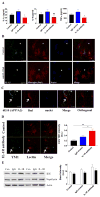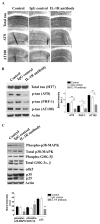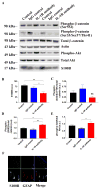Blocking IL-1 signaling rescues cognition, attenuates tau pathology, and restores neuronal β-catenin pathway function in an Alzheimer's disease model
- PMID: 22095718
- PMCID: PMC4072218
- DOI: 10.4049/jimmunol.1100620
Blocking IL-1 signaling rescues cognition, attenuates tau pathology, and restores neuronal β-catenin pathway function in an Alzheimer's disease model
Abstract
Inflammation is a key pathological hallmark of Alzheimer's disease (AD), although its impact on disease progression and neurodegeneration remains an area of active investigation. Among numerous inflammatory cytokines associated with AD, IL-1β in particular has been implicated in playing a pathogenic role. In this study, we sought to investigate whether inhibition of IL-1β signaling provides disease-modifying benefits in an AD mouse model and, if so, by what molecular mechanisms. We report that chronic dosing of 3xTg-AD mice with an IL-1R blocking Ab significantly alters brain inflammatory responses, alleviates cognitive deficits, markedly attenuates tau pathology, and partly reduces certain fibrillar and oligomeric forms of amyloid-β. Alterations in inflammatory responses correspond to reduced NF-κB activity. Furthermore, inhibition of IL-1 signaling reduces the activity of several tau kinases in the brain, including cdk5/p25, GSK-3β, and p38-MAPK, and also reduces phosphorylated tau levels. We also detected a reduction in the astrocyte-derived cytokine, S100B, and in the extent of neuronal Wnt/β-catenin signaling in 3xTg-AD brains, and provided in vitro evidence that these changes may, in part, provide a mechanistic link between IL-1 signaling and GSK-3β activation. Taken together, our results suggest that the IL-1 signaling cascade may be involved in one of the key disease mechanisms for AD.
Figures






References
-
- Lee YJ, Han SB, Nam SY, Oh KW, Hong JT. Inflammation and Alzheimer's disease. Archives of pharmacal research. 2010;33:1539–1556. - PubMed
-
- McGeer PL, Schulzer M, McGeer EG. Arthritis and anti-inflammatory agents as possible protective factors for Alzheimer's disease: a review of 17 epidemiologic studies. Neurology. 1996;47:425–432. - PubMed
-
- Breitner JC, Gau BA, Welsh KA, Plassman BL, McDonald WM, Helms MJ, Anthony JC. Inverse association of anti-inflammatory treatments and Alzheimer's disease: initial results of a co-twin control study. Neurology. 1994;44:227–232. - PubMed
Publication types
MeSH terms
Substances
Grants and funding
- P01 AG000538/AG/NIA NIH HHS/United States
- NS050895/NS/NINDS NIH HHS/United States
- RF1 AG020241/AG/NIA NIH HHS/United States
- R01 NS050895/NS/NINDS NIH HHS/United States
- AG00538/AG/NIA NIH HHS/United States
- R01AG20335/AG/NIA NIH HHS/United States
- P50AG16573/AG/NIA NIH HHS/United States
- R01 AG020241/AG/NIA NIH HHS/United States
- R01 AG021982/AG/NIA NIH HHS/United States
- AG020241/AG/NIA NIH HHS/United States
- R01 AG020335/AG/NIA NIH HHS/United States
- K99AR054695/AR/NIAMS NIH HHS/United States
- K99 AR054695/AR/NIAMS NIH HHS/United States
- P50 AG016573/AG/NIA NIH HHS/United States
LinkOut - more resources
Full Text Sources
Other Literature Sources
Medical
Molecular Biology Databases
Miscellaneous

